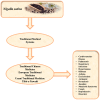Antimicrobial Properties and Therapeutic Potential of Bioactive Compounds in Nigella sativa: A Review
- PMID: 39459282
- PMCID: PMC11510594
- DOI: 10.3390/molecules29204914
Antimicrobial Properties and Therapeutic Potential of Bioactive Compounds in Nigella sativa: A Review
Abstract
Nigella sativa (N. sativa; Ranunculaceae), commonly referred to as black cumin, is one of the most widely used medicinal plants worldwide, with its seeds having numerous applications in the pharmaceutical and food industries. With the emergence of antibiotic resistance in pathogens as an important health challenge, the need for alternative microbe-inhibitory agents is on the rise, whereby black cumin has gained considerable attention from researchers for its strong antimicrobial characteristics owing to its high content in a wide range of bioactive compounds, including thymoquinone, nigellimine, nigellidine, quercetin, and O-cymene. Particularly, thymoquinone increases the levels of antioxidant enzymes that counter oxidative stress in the liver. Additionally, the essential oil in N. sativa seeds effectively inhibits intestinal parasites and shows moderate activity against some bacteria, including Bacillus subtilis and Staphylococcus aureus. Thymoquinone exhibits minimum inhibitory concentrations (MICs) of 8-16 μg/mL against methicillin-resistant Staphylococcus aureus (MRSA) and exhibits MIC 0.25 µg/mL against drug-resistant mycobacteria. Similarly, quercetin shows a MIC of 2 mg/mL against oral pathogens, such as Streptococcus mutans and Lactobacillus acidophilus. Furthermore, endophytic fungi isolated from N. sativa have demonstrated antibacterial activity. Therefore, N. sativa is a valuable medicinal plant with potential for medicinal and food-related applications. In-depth exploration of the corresponding therapeutic potential and scope of industrial application warrants further research.
Keywords: Nigella sativa; antibiotic; antimicrobial; bioactive compounds; medicinal plant; microorganisms; thymoquinone.
Conflict of interest statement
The authors declare no conflicts of interest.
Figures






References
-
- Allen H.K. NAM Perspectives. National Academy of Medicine; Washington, DC, USA: 2017. Alternatives to Antibiotics: Why and How. - DOI
Publication types
MeSH terms
Substances
LinkOut - more resources
Full Text Sources
Molecular Biology Databases

